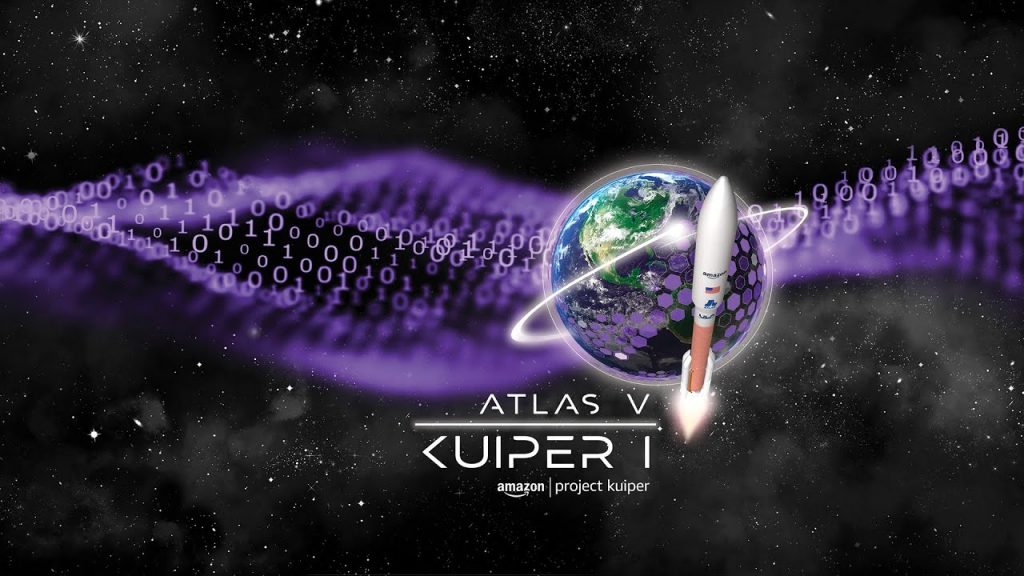Amazon is taking significant strides towards revolutionizing internet access globally with its Project Kuiper satellite constellation. The upcoming launch on April 9, 2025, of the first batch of operational satellites represents a historic moment not just for Amazon, but for the future of broadband connectivity, especially in underserved regions of the world.
The Launch Details
The launch, scheduled for 7 p.m. EDT (2300 GMT) from Cape Canaveral Space Force Station, will deploy 27 satellites into low Earth orbit using a United Launch Alliance (ULA) Atlas V rocket. This mission, designated Kuiper 1, marks an important step in Amazon’s multi-year endeavor to establish a megaconstellation designed to provide reliable, high-speed internet globally.

Coverage of the launch will begin earlier in the day at 6:35 p.m. EDT (2235 GMT), allowing spectators to witness the launch live, providing a more intimate look into this technological milestone.
Ambitious Goals Behind Project Kuiper
Project Kuiper aims to deploy around 3,200 satellites in total, creating a network that can deliver robust internet coverage wherever it is needed. Rajeev Badyal, vice president of Project Kuiper, emphasizes that these satellites are designed with advanced technologies capable of significantly expanding Amazon’s broadband capacity. “We’ve designed some of the most advanced communications satellites ever built,” Badyal remarks. “Every launch is an opportunity to add more capacity and coverage to our network.”
With this upcoming launch, Amazon expects to deploy its final satellite design for the first time and learn critical operational insights that can only be gleaned in-flight. The experiment represents just the beginning of a much larger effort to improve internet access worldwide.
Operational Timeline and Future Launches
Amazon’s ambitious timeline includes a goal to launch the first 578 satellites by mid-2026, a requirement set by the Federal Communications Commission (FCC) to begin offering services. As highlighted in earlier communications, the company aims to deploy the entire constellation by 2029. To meet these deadlines, Amazon will need to maintain a steady launch tempo — averaging approximately 100 launches annually across various launch platforms.
Amazon has inked contracts with multiple launch providers, including ULA, Arianespace, Blue Origin, and SpaceX, demonstrating a flexible yet ambitious launch strategy. After the upcoming Atlas V mission, several more launches are slated for various rockets, including ULA’s Vulcan Centaur, which can carry up to 45 satellites per launch.
The Mechanisms Behind the Satellites
While details about the specific functionalities of individual satellites have remained under wraps, Amazon has iterated that significant improvements have been integrated from its earlier prototypes. Enhanced phased-array antennas, advanced processors, larger solar arrays, and revolutionary propulsion systems are among the upgrades aimed at optimizing communications and operational efficiency.
Technical Specifications and Characteristics
- Orbital Altitude: 630 km, strategically placed to minimize latency and improve coverage.
- Orbital Configuration: 3,236 satellites organized across 98 orbital planes.
- Mission Design: Each satellite will provide broadband services to individual customers and interconnected nodes via high-capacity optical links.
Challenges and Operations Ahead
Given the complexities of satellite technology and orbital mechanics, challenges remain ahead for the successful deployment of Project Kuiper. Amazon’s team must navigate potential regulatory obstacles, technical challenges, and the ever-present risk associated with launching multiple satellites simultaneously. Badyal asserts the company’s readiness, highlighting extensive testing and preparation. “We’ve done extensive testing on the ground to prepare for this first mission. However, there are some things you can only learn in flight,” he notes.
The Broader Implications of Project Kuiper
Project Kuiper is not just a corporate initiative; it holds the potential to democratize internet access across geographical and socio-economic barriers. If successful, the initiative could bridge the digital divide that currently affects millions globally, providing significant opportunities for communities to engage with the internet, education, and economic development.
The implications extend beyond internet access; they encompass global connectivity, international partnerships for infrastructure sharing, and collaboration with governments for regulatory alignment to ensure a successful service rollout.
Conclusion
The impending launch of Project Kuiper’s first full-scale satellite batch represents a significant chapter in Amazon’s ambitious quest for global broadband coverage. As the countdown to the launch begins, industry watchers and consumers alike anticipate the connectivity revolution that this satellite mega-constellation could usher in across the globe.
In the coming days, we will learn more about how these satellites perform in orbit, and whether Amazon’s promising vision will come to fruition in the months and years ahead.
“This is just the start of our journey, and we have all the pieces in place to learn and adapt as we prepare to launch again and again over the coming years.” – Rajeev Badyal
As the world watches, the future of internet connectivity hangs in the balance, and the success of Project Kuiper may very well determine the effectiveness of satellite internet services for future generations.

